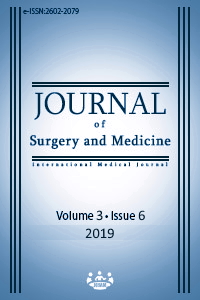Assessment of the superior turbinate pneumatization and concomitant nasal pathologies on computed tomography
Keywords:
Paranasal sinuses, Anatomical variation, Pneumatized turbinate, Computed tomographyAbstract
Aim: Knowledge of the anatomical variations of the nasal cavity is extremely important for the safety and ease of endoscopic sinus surgery applications. The aim of the current study was to evaluate the incidence and uni/bilaterality of superior nasal turbinate pneumatization (STP). In addition, we aimed to investigate the frequency of middle turbinate pneumatization (MTP), nasal septum deviation (NSD) and paradoxical middle concha (PMC), and to relate the presence of these pathologies to the presence of STP.
Methods: We retrospectively reviewed the images of 358 consecutive patients who undertaken paranasal sinus computed tomography within five months’ time in our institution. The presence and uni/bilaterality of the STP and MTP as well as the presence of NSD and PMC were noted. The relation of the STP with MTP, NSD and PMC were evaluated. Besides, the relationship between nasal variations and gender and age was evaluated.
Results: Of 358 patients, 105 (29.3%) had STP with 51 (48.6%) being bilateral and the remaining 54 (51.4%) being unilateral. The number of patients with accompanying MTP, NSD and PMC were 84 (80%), 63 (60%) and 32 (30.5%), respectively. No significant relationship between STP with NSD or PMC was recorded. However, STP significantly associated with MTP. We also noted that the patients with either STP or MTP were significantly younger than those without STP or MTP.
Conclusion: The knowledge of the variations of the structures that determine the nasal cavity anatomy and how often these variations are seen will enable the endoscopic surgical procedures to be performed easily and safely.
Downloads
References
Cagici CA, Yavuz H, Erkan AN, Akkuzu B, Ozluoglu L. Evaluation of anatomic variations of the paranasal sinuses by computed tomography. Turk Arch Otolaryngol. 2006;44(4):201–10.
Koo SK, Kim JD, Moon JS, Jung SH, Lee SH. The incidence of concha bullosa, unusual anatomic variation and its relationship to nasal septal deviation: a retrospective radiologic study. Auris Nasus Larynx. 2017;44(5):561–70.
Pittore B, Al Safi W, Jarvis SJ. Concha bullosa of the inferior turbinate: an unusual cause of nasal obstruction. Acta Otorhinolaryngol Ital. 2011:31(1):47–9.
Orlandi RR, Lanza DC, Bolger WE, Clerico DM, Kennedy DW. The forgotten turbinate: the role of the superior turbinate in endoscopic sinus surgery. Am J Rhinol. 1999;13:251–59.
Kantarci M, Karasen RM, Alper F, Onbas O, Okur A, Karaman A. Remarkable anatomic variations in paranasal sinus region and their clinical importance. Eur J Radiol. 2004;50(3):296–302.
İla K, Yilmaz N, Öner S, Başaran E, Öner Z. Evaluation of superior concha bullosa by computed tomography. Surg Radiol Anat. 2018 Jul;40(7):841-6.
Sivasli E, Sirikci A, Bayazit YA, Gümüsburun E, Erbagci H, Bayram M, et al. Anatomic variations of the paranasal sinus area in pediatric patients with chronic sinusitis. Surg Radiol Anat. 2003;24(6):400–5.
Shpilberg KA, Daniel SC, Doshi AH, Lawson W, Som PM. CT of anatomic variants of the paranasal sinuses and nasal cavity: poor correlation with radiologically significant rhinosinusitis but importance in surgical planning. AJR Am J Roentgenol. 2015;204(6):1255–60.
Santorinus DJ. Observationes anatomicae, 1739; 88–89 Cited in Braun H, Stammberger H. Pneumatization of turbinates. Laryngoscope 2003;113:668–72.
Uzun L, Aslan G, Mahmutyazicioglu K, Yazgan H, Savranlar A. Is pneumatization of middle turbinates compensatory or congenital? Dentomaxillofac Radiol. 2012;41(7):564–70.
Fidan V. Panconcha bullosa: new definition in the literature. J Craniofac Surg. 2012;23(3):253–4.
Toplu Y, Bayindir T, Karatas E, Akarcay M. All concha bullosa: an undefined abnormality of the lateral nasal wall. Indian J Otolaryngol Head Neck Surg. 2013;65(1):86–8.
Cobzeanu MD, Bâldea V, Bâldea MC, Vonica PS, Cobzeanu BM. The anatomo-radiological study of unusual extrasinusal pneumatizations: superior and supreme turbinate, crista galli process, uncinate process. Rom J Morphol Embryol. 2014; 55(3 Suppl):1099–104.
Ahn JC, Lee WH, We J, Rhee CS, Lee C, Kim JW. Nasal septal deviation with obstructive symptoms: Association found with asthma but not with other general health problems. Am J Rhinol Allergy. 2016 Mar-Apr;30(2):e17-20.
Stallman JS, Lobo JN, Som PM. The incidence of concha bullosa and its relationship to nasal septal deviation and paranasal sinus disease. AJNR Am J Neuroradiol. 2004;25(9):1613–8.
Arslan H, Aydinlioglu A, Bozkurt M, Egeli E. Anatomical variations of the paranasal sinuses: CT examination for endoscopic sinus surgery. Auris Nasus Larynx. 1999;26:39–48.
Bolger WE, Butzin CA, Parsons DS. Paranasal sinus bony anatomic variations and mucosal abnormalities. Laryngoscope. 1991;101:56–64.
Ozcan KM, Selcuk A, Ozcan I, Akdogan O, Dere H. Anatomical variations of nasal turbinates. J Craniofac Surg. 2008;19(6):1678–82.
Downloads
- 1639 2207
Published
Issue
Section
How to Cite
License
Copyright (c) 2019 Meltem Özdemir, Rasime Pelin Kavak
This work is licensed under a Creative Commons Attribution-NonCommercial-NoDerivatives 4.0 International License.
















